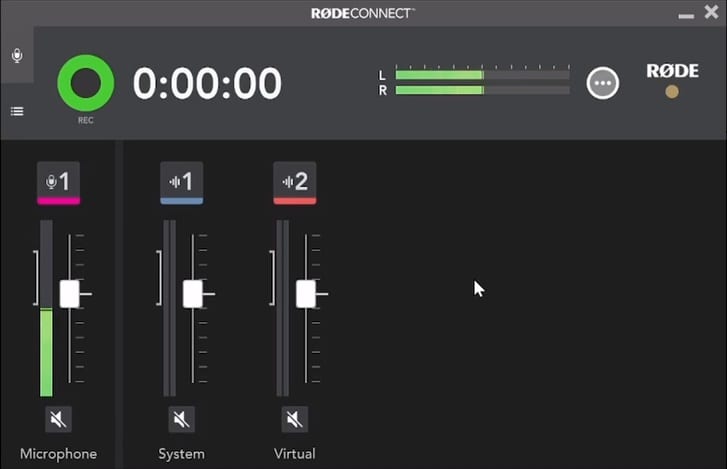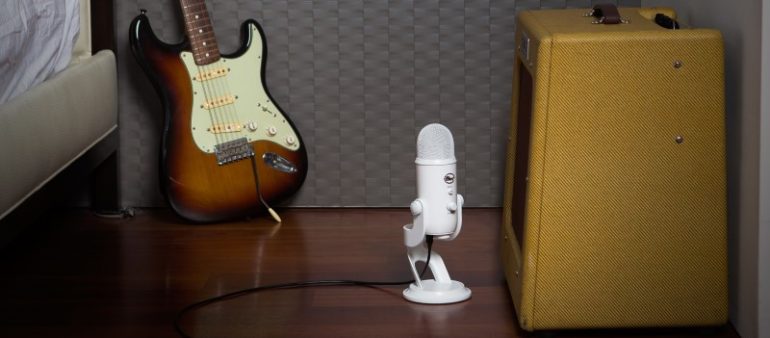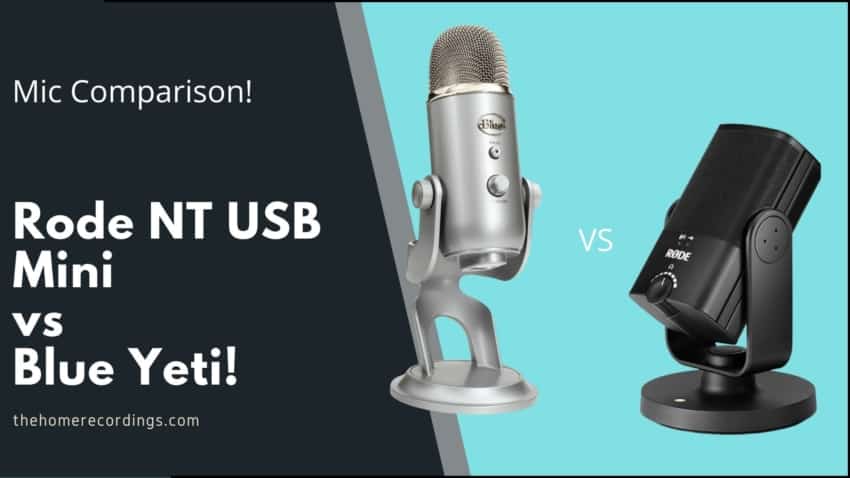Last updated on December 29th, 2023 at 09:53 pm
The Rode NT USB Mini has taken the market by storm, but is it good enough to dethrone the famous Blue Yeti?
In this article, I will be comparing both microphones, going over how they sound, their build quality, what they are good for, their included software, and more.
So, without any further ado, let’s get started!
In short, here are the differences between the Rode NT USB Mini and Blue Yeti: Both are condenser microphones but the Blue Yeti features four polar patterns to the Rode’s one. However, the Rode NT USB Mini has a better sound overall and it comes with the Rode Connect software which is designed to let you process the signal further.
So, let’s get this show on the road, shall we?
Rode NT-USB Mini Overview

The Rode NT USB Mini is the little brother of the Rode NT USB, and it comes with the same feature set but at a much lower price tag. However, I don’t think that it sounds as full, but more on this in a second.
As far as the build quality goes, everything but the grille is excellent, since the grille does flex a little more than the one on the Rode NT USB (the big one), but it’s definitely not enough for me to worry about it getting damaged.
It features one knob on the front that lets you control the headphone volume and that also allows you to enable zero-latency monitoring when tapping on it. A light on top of the knob will turn on indicating that zero-latency monitoring is enabled (the second light only tells you if the mic is connected and getting power).
It comes with a 360-degree swing mount that is great for setting up the mic on a boom arm since you can turn it however you want until you get it just right.
Contrary to its bigger brother, the NT USB Mini doesn’t come with an included pop filter, but rather has one already built-in, although I have to say that plosives are still kind of an issue and I would recommend using an external pop filter just in case.
Now, you may have noticed that it only has one knob, which is the one that controls the headphone volume, but where are the gain and Mix knobs? Well, there are none, which is a shame, and you need to control both of these functions from your PC.
I through Rode would’ve learned after not including a gain dial on the NT USB, but they actually went further and removed one more knob.
It’s worth mentioning, however, that even though it would be nice to have dedicated knobs to control the gain and the mix between the computer’s playback and the direct signal, all of this can easily be adjusted through their Rode Connect software.

The Rode Connect software lets you use up to 4 Rode NT USB Minis one a single computer, access some processing which are built into the mic, such as a gate, compression, and more, and it also lets you control the playback volume of different apps and games, which lets you create a nice mix for your stream (great software for gamers).
Lastly, it doesn’t come with a shock mount, and when using it with the included desk stand, it will absolutely pick up all the keyboard strokes, tapping on the desk, or any other types of vibrations that may be present. So, for all you gamers out there, get a boom arm!
What comes in the Box?
- Rode NT USB Mini Microphone
- Desktop Stand
- Microphone Stand adapter
- UNB Cable
Features
- Comes with the Rode Connect Software (Great for streamers & gamers)
- Built-in pop filter.
How does it sound?
The Rode NT USB Mini offers a very balanced sound, especially when recording voice-related stuff and singing: The low end isn’t too prominent or boomy while still being extremely present, the mids are actually quite prominent but I like how this affects the vocals, and the high end is very open and airy without sounding shrill.
So, at least as far as vocals goes, it’s a very balanced sound, and I though the same when recording my acoustic guitar since there was nothing really standing out to me as overly harsh.
The one con I can think of is that, since the mid frequencies are a bit more prominent than in other mics, people who have a very nasally voice might find that that nasally sound will be slightly exaggerated.
Lastly, when recording my electric guitar, it sounded great when recording a clean signal, but I didn’t really like recording distorted guitars with it since it made them sound quite shrill.
And lastly, the headphone amp that the Mini comes with is great: It has enough power to drive the Sennheiser HD 650!
Specifications
- Polar Pattern; Cardioid
- Frequency Response: 20Hz- 20kHz
- Sample Rate: 48kHz/24-bit
- Max SPL: 121dB
- Weight: 585g
Get the Rode NT USB MINI here.
- Rode NT USB MINI: Amazon, Sweetwater.
Blue Yeti

Blue is known for making excellent quality, cool-looking and VERY expensive microphones. Luckily, the Blue Yeti won’t break the bank.
It’s their most famous microphone which works through USB and is plug n’ play, meaning that all you need to do is connect it and that’s it, it’s ready for use, and it will work perfectly on both Windows and Mac OS.
The build quality is great, it feels very durable and not like some cheap microphone that seems as if it’s going to break anytime soon. However, I have to mention that it’s a gigantic microphone and it might get in the way if you set it up on the desk using the included desk stand.
It features a multitude of pickup patterns, such as Cardioid, omni- & bidirectional, and stereo, which makes the Blue Yeti quite versatile.
It is not only an excellent microphone for podcasters, YouTubers and Voice-over artists, but it’s also pretty good for recording music… emphasis on pretty good.
This microphone also comes with a Gain control, mute button and a zero-latency headphone output, which is on the bottom.
All the knobs are easy to use and you can quickly tell how much- or how little gain you’re dialing in.
The reason the Blue Yeti is a good option for recording music is, apart from its good sound quality, that it can record in stereo.
Why is the stereo pattern so useful?
We usually record acoustic guitars, pianos, etc. using two pencil condenser microphones which, when combined, give us a really nice stereo feel.
While the Blue Yeti won’t give you the exact same results as the two pencil microphones, it will certainly give you a better result than using a single cardioid microphone, at least in terms of stereo feel.
Another plus is that if you already own a cardioid microphone you can use the omni setting on the Blue Yeti and record with both of them at the same time using the mid-side technique which is an excellent way of creating a stereo recording.
What comes in the Box?
- The Blue Yeti Microphone
- USB Cable
Features
- Tri-capsule array: three condenser capsules inside
- Multiple pattern selection: cardioid, stereo, omnidirectional and bidirectional
- Gain control, mute button, zero-latency headphone output
- Perfect for podcasting, voiceovers, game streaming, interviews, conference calls and music recording
- Plug ‘n play: Mac and PC compatible
- Desk stand included (already attached to the mic)
How does it Sound?
The Blue Yeti is very easy to use and doesn’t require any technical knowledge to be configured, just connect and use without the need to worry about any drivers or latency issues.
The sound quality is very good considering the price, plus having four different pickup patterns allows for a lot of versatility.
Do you need to record a bunch of people for a podcast? Or do you need to record and ensemble? Or maybe you just want it to have a conversation over skype… With all of these pickup patterns you can easily do all of this without any issues.
I liked it especially for voice-related applications but, like I mentioned earlier, not so much for recording music.
This is because, even though the stereo pickup pattern can come in handy when recording something like an acoustic guitar, I just didn’t like the way it sounded as much; It doesn’t sound as bright as I would have hoped, which is why I said that it sounds “good” and not “great”. It kind of lacks personality.
Don’t get me wrong, it’s a great microphone and it’s super worth the money, plus someone with an untrained ear probably won’t even notice these subtleties.
If you want a good microphone for a podcasting project or simply for making YouTube videos, then I think that you should choose the Blue Yeti, especially if you are going to use the different pickup patterns.
Specifications
- Polar Pattern; Cardioid, stereo, omni- and bidirectional
- Frequency Response: 20Hz- 20kHz
- Sample Rate: 48kHz/16-bit
- Max SPL: 120dB
- Weight: 1.2 lbs
If you’re looking for a versatile microphone, then it might be a good idea to go for the Blue Yeti.
Get the Blue Yeti here.
- Blue Yeti: Amazon, Sweetwater.
Which one should you go for?
These two microphones are completely different and serve different purposes (because of the Yeti’s four polar patterns). Although, it’s worth noting that you will be using the cardioid pattern 99% of the time unless you’re using the stereo pattern to record music, or the omni/bidirectional ones to record a podcast.
If you’re only going to be using the cardioid pattern, then go with the Rode NT USB Mini. Not only does it sound slightly better but it also sells for a lot less, plus it’s tiny when compared to the Yeti.
The only reason I would go with the Yeti is if I really need a multi-polar microphone, but that’s really the only reason.
Still, I believe that the Rode wins overall because of the lower price tag.
Other alternatives
I reviewed a couple USB mics already and there are two that stand out: The Audio-Technica AT2020+ USB and the Samson G-Track Pro.
The AT2020+ USB sounds great, similar to the Rode NT USB Mini, but it doesn’t come with the included software, so I don’t think it’s as good for streamers, but musicians will love it.
The Samson G-Track Pro is an interesting alternative, mainly for guitarists and bassists since it features an instrument jack that lets you record both the microphone signal and the instrument signal to separate tracks, and you can even use it with amp simulation software with very low latency.
Conclusion
The Rode NT USB Mini is definitely making quite a name for itself because of how great it sounds, the included software, and the extremely low price tag, and since it costs less than most other USB microphones out there, I’d say that it’s clearly the better choice in most scenarios.
The great thing is that, at least from what I’ve been able to tell, the prices of mics such as the Blue Yeti, AT2020 USB, ElGato Wave 3, etc., have started to drop because of it, which is fantastic to see! Competition is the best.
